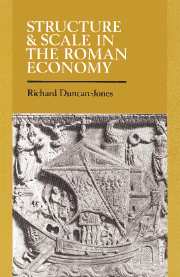Book contents
- Frontmatter
- Contents
- List of figures
- List of tables
- Preface
- List of abbreviations
- Introduction
- PART I TIME AND DISTANCE
- PART II DEMOGRAPHY AND MANPOWER
- PART III AGRARIAN PATTERNS
- PART IV THE WORLD OF CITIES
- PART V TAX-PAYMENT AND TAX-ASSESSMENT
- 12 Taxation in money and taxation in kind
- 13 Land, taxes and labour: implications of the iugum
- Appendices
- Bibliography
- Index
12 - Taxation in money and taxation in kind
Published online by Cambridge University Press: 13 October 2009
- Frontmatter
- Contents
- List of figures
- List of tables
- Preface
- List of abbreviations
- Introduction
- PART I TIME AND DISTANCE
- PART II DEMOGRAPHY AND MANPOWER
- PART III AGRARIAN PATTERNS
- PART IV THE WORLD OF CITIES
- PART V TAX-PAYMENT AND TAX-ASSESSMENT
- 12 Taxation in money and taxation in kind
- 13 Land, taxes and labour: implications of the iugum
- Appendices
- Bibliography
- Index
Summary
Introduction
Despite prevalent assumptions that its character is well known, the surviving details of provincial taxation under the Principate are remarkably incomplete. Under Augustus some systematisation evidently took place, with the introduction of provincial censuses. The epigraphic evidence does not in itself suggest that these were regular (the surviving references per province are very few save those for Gallia Comata), or that they were introduced in all provinces (the evidence is concentrated overwhelmingly in the ‘imperial’ provinces). Censuses involved, or could involve, surveys of land and property as well as of population. Their occurrence implies that tax was being proportioned in some way to assets, instead of being levied as a fixed amount, which might be arbitrary.
But census-taking was made necessary by poll–tax, if nothing else. Though poll–taxes were levied in money, the occurrence of a census does not in itself indicate that land in the province was taxed in money. The evidence about the way in which the main tax of a province was paid reveals diversity, not consistency.
The evidence of Hyginus
The closest that any ancient source comes to a general description of Roman tax-regimes is in a passage from the second–century land–surveyor Hyginus (205L). Soon after distinguishing between tax–free land (ager immunis) and land liable to tax (ager vectigalis), Hyginus gives a brief description of the way in which direct taxes are assessed.
- Type
- Chapter
- Information
- Structure and Scale in the Roman Economy , pp. 187 - 198Publisher: Cambridge University PressPrint publication year: 1990
- 1
- Cited by



